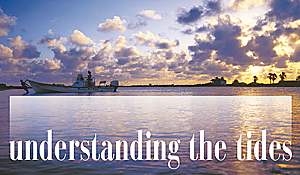|

How to turn the TF&G Almanac
into a precise fishing formula that will give you
a decided edge when angling the Texas Coast
By Chester Moore, Jr.
Page 2
But if you dig deeper into charts that the National Oceanic and
Atmospheric Administration (NOAA) maintains as we do, you would
find some very interesting information about those same tides.
You would learn that the tide is forecast to drop only 8 inches
between the 3:35 a.m. high and 8:55 a.m. low. And it is forecast
to rise only about 5 inches between that 8:55 a.m. low and 12:50
p.m. high.
But you would also learn that between that 12:50 p.m. high and
the 8:37 p.m. low, the tide is forecast to drop more than 2-1/2
feet-a very strong tide for the Texas Gulf Coast.
Now let's suppose someone decides to go fishing on that Tuesday
morning and doesn't look at our tidal chart, but instead glances
at the tide times on television.
He sees there will be a low tide at 8:55 a.m. and a high tide
at 12:50 p.m., so he assumes the tide at the Sabine jetties will
be rising between those two times. It will, but it will rise only
5 inches, which is an inch an hour.
He probably won't even notice the change. And he'll come back
convinced the television was wrong.
To properly base a fishing trip around tidal movements, the key
thing to watch is how much change will occur between tides. Just
reading the general tide table is a waste of time. An angler must
use the aforementioned "Tidal Correction Table" to adjust
for tidal movements in the area he plans to fish.
Once learning how to read tide charts is mastered, there are
a few other things to keep in mind that can help you successfully
fish around tides.
It's important to always watch the charts for quick tidal turnarounds
and swings from one extreme to the other in a short period of
time. The faster the water is moving, the more prey is displaced
from its cover and put into the open water.
When jetty fishing it is often better along the Gulf side during
an incoming tide, but the action usually shifts to the channel
side on an outgoing. This is because shrimp, shad and other baitfish
are being flushed from the bay systems toward the Gulf.
Remember that tidal movement is always the most out of proportion
and visible around passes and inlets. That is because water in
these narrow areas is being forcefully funneled through them.
However, in the bays or in the ocean, it isn't always easy to
tell when the current is moving or in which direction.
Sometimes there is a conflict between wind and tide, and on a
weak tide with a strong wind it can be especially hard to tell
which force is moving which way.
A good way to find which way the tide is moving is to find some
structure and look for signs of movement around it. If you're
wading you can kick up some sand and see which direction it settles.
Or if you're in a boat, you can pitch out a light, sinking lure
and see which way it moves.
Once you get comfortable with reading the tides and learning
how they intimately affect the areas you fish, there's no question
your rate of angling success will increase.
Tides are what separate the methods employed in saltwater and
freshwater fishing. And the understanding of them is often what
separates those who catch fish in saltwater from those who don't.
# # # #
page 1 / page 2
| 




